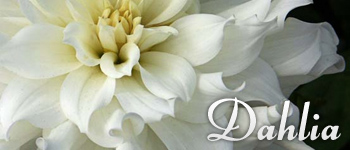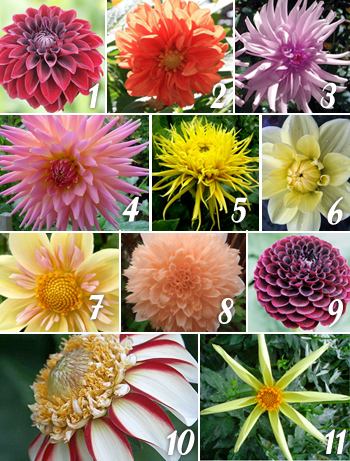Tis the season! For Dahlias that is. August is the peak blooming month for Dahlias, and the folks over at Dahlia Dell in the Golden Gate Park of San Fransisco couldn’t be happier. Dahlias have had their own special plot in the park since the 1920s. Dahlias are even San Fransisco’s official flower!
San Fransico Mayor Gavin Newsom declared Saturday, August 21st, to be Dahlia Flower Day in San Fransisco.
DAHLIA
Use: Flower
Type: Tuberous Perennials
Height: 8-20″
GROWING
Planting Zones: 7-11
Requirements: Humus-rich, well-drained soil in full sun.
DESIGNING
Stem: 10-20″
Blossom Size: 2-10″ diameter
Texture: Satin
Silhouette: Dense/Round
Vase Life: 3-7 Days
Colors: Large Variety
Bloom Season: Mid summer to late frost.
Flowers Available: Year Round
ABOUT DAHLIAS
The Dahlia is one of the most beautiful of the native American flowers. They were used abundantly by the Aztecs of Mexico, as food, medicine and of course, decorations!
 Very little is known about the early history of the Dahlia due to the destruction of the Aztec culture after the Spanish Conquest. Francisco Hernadez was sent to Mexico by King Phillip II of Spain in 1570 to study it’s natural resources. He stayed for 7 years and was the first to describe the plants we know as Dahlias today. He called them Acocotli and Cocoxochitl.
Very little is known about the early history of the Dahlia due to the destruction of the Aztec culture after the Spanish Conquest. Francisco Hernadez was sent to Mexico by King Phillip II of Spain in 1570 to study it’s natural resources. He stayed for 7 years and was the first to describe the plants we know as Dahlias today. He called them Acocotli and Cocoxochitl.
In October of 1789, the first Dahlia bloomed in Europe at the Madrid Botanical Garden. By the early part of the 1800s, Dahlias were growing in luxurious gardens all over Europe.
The thing about Dahlias that sets them apart from other flowers in the plant world is the fact that they are octoploids. This means they have eight sets of chromosomes, whereas most plants only have two. (Humans have 23.) This gives the Dahlia the unique ability to be cultivated with a extremely high variety of results.
CLASSIFICATION OF DAHLIAS
Dahlia varieties are based not only on shape, but size. Dahlias are a genus with 30 species and over 20,000 cultivars… (Big family!)
Dahlia Size Categories:
- Giant (AA) – over 10″ diameter
- Large (A) – 8-10″ diameter
- Medium (B) – 6-8″ diameter
- Small (BB) – 4-6″ diameter
- Miniature (Min) – 2-4″ diameter
- Mignon – to 2″ diameter
1. Formal Decorative Dahlias (FD) – flat, rounded florets regularly arranged.
2. Informal Decorative Dahlias (ID) – twisty, curvy or wavy florets arranged irregularly.
3. Semi-cactus Dahlias (SC) – ray florets that can be straight, incurved or recurved
4. Straight-cactus Dahlias (C)- ray florets arranged regularly
5. Laciniated Dahlias (LC) – twisted and split, ray florets
6. Waterlily Dahlia (WL) – broad, slightly cupped florets
7. Collarette Dahlia – single row of ray florets around a center ring of shorter florets
8. Anemone Dahlia – ray florets composed around central tubular disk florets
9. Ball (Ba), Miniature Ball (MBa) Pompon (P) – ball-shaped or slightly flatted flowerheads
10. Single Dahlia – One row of uniform, ray florets
11. Orchid Dahlias – single row of ray florets with inward-curving margins
Novelty Dahlias (NO) – Dahlias whose characteristics do not fit into any other category.
Dahlias are a great addition to fall flower favorites. With their wide color varieties and late-summer blooming season, this versatile flower is a great addition to your fall flower arrangements and centerpieces. Check out this great article on 2010 Fall Floral Design Trends and get a jump-start on planning your fall floral decor today!
This post is brought to you by local San Francisco, CA florists.
Not in San Fran? Use Flower Shop Network‘s handy directory to find YOUR real local florist!


 Find Your
Find Your 
